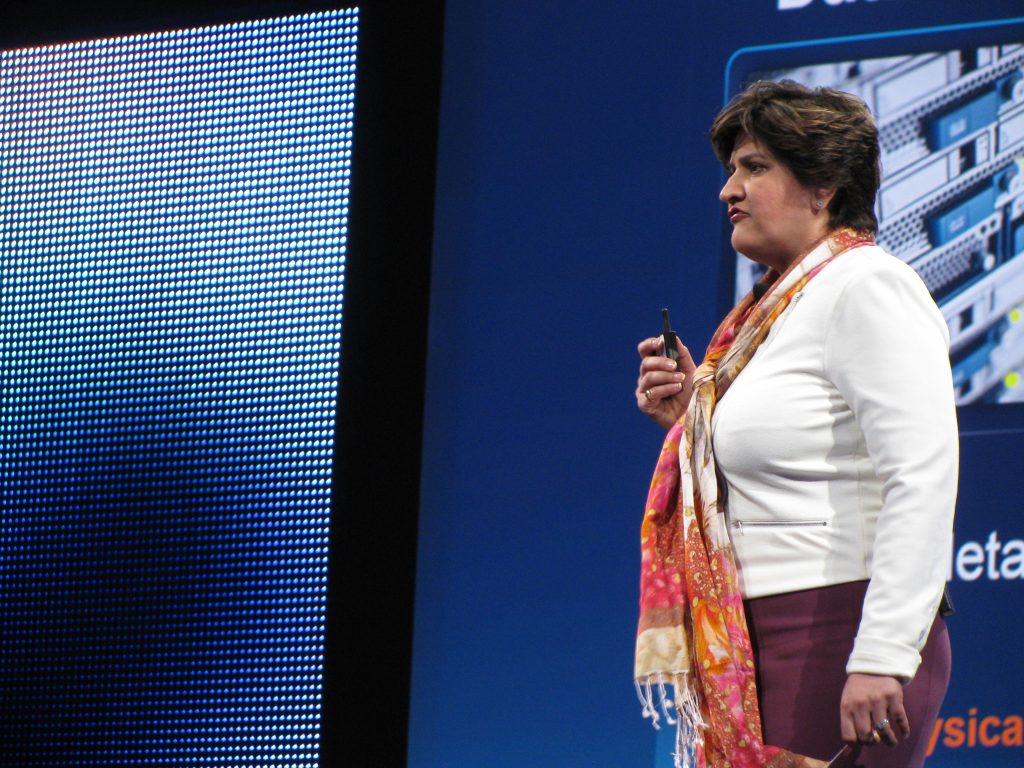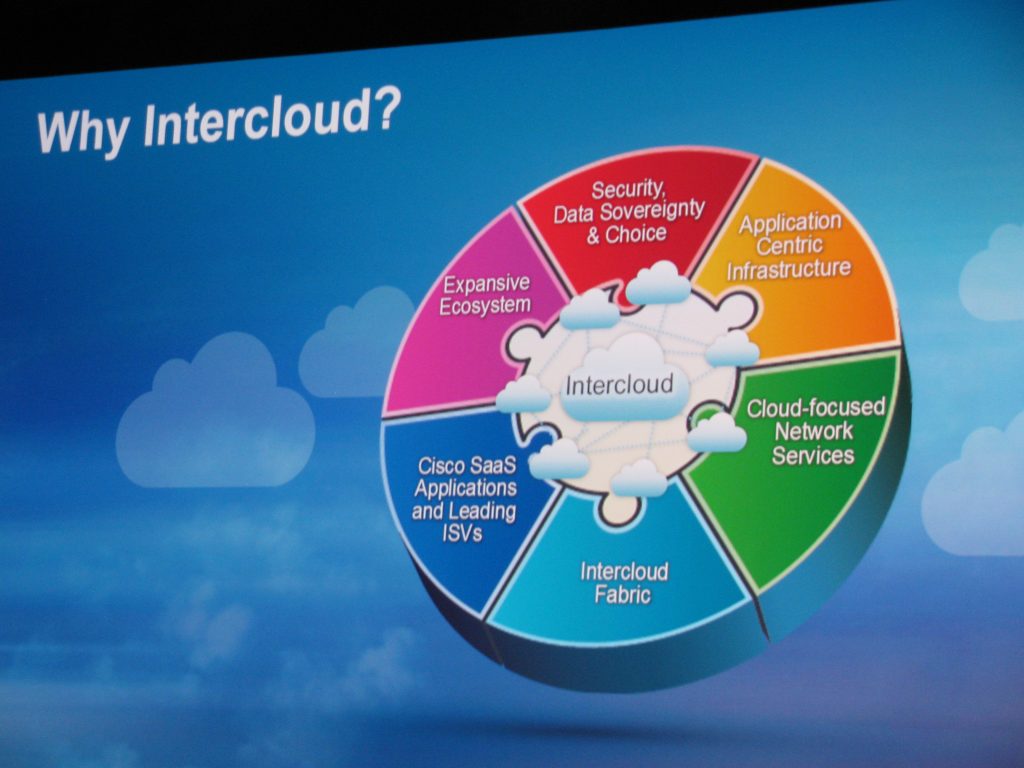It’s day two of Cisco Live and VCE is right up front and center at the keynote. We anticipate that there will be a lot of exciting news around the Application Centric Infrastructure and Intercloud.
9:53 pm PT
Everyone is starting to come into the general session – get your seats fast, they’re filling up!

10:02 am PT
Blair Christie takes the Cisco Live stage and does a selfie with the whole audience!
10:06 am PT
Blair welcomes Ben Davis, founder of Illuminate the Arts, to the stage. Ben used Cisco Catalyst switches in his art project to illuminate the bridge connecting San Francisco to Oakland. He is describing the challenges he faced to create the installation.
10:11 am PT
Blair discusses that we need a new model for IT – Fast IT – to simplify and transform IT operations. She then welcomes Rob Lloyd, President, Development and Sales, Cisco, to the stage to discuss the Application Centric Infrastructure and Intercloud.
10:16 am PT
Lloyd states that new rules are emerging due to the cloud. Cisco is focusing on hybrid cloud. He states that Cisco is #1 in Cloud infrastructure and mentions that products like the VCE Vblock Systems are a big part of this.
10:18 am PT
Cisco wants to be #1 in the Hybrid Cloud by using the Intercloud and Application Centric Infrastructure, which will be extremely important in the Internet of Everything. The Intercloud will be the platform on the Internet of Everything.
10:20 am PT
10:23 am PT
Cisco Cloud Services like Meraki, cloud based security, monitoring services and Webex are a big part of the Cisco cloud story. Intercloud will use public APIs to move workloads to AWS and soon Azure.
10:28 am PT
Cisco is building an ecosystem of cloud service providers globally. This will allow for local data sovereignty. They want to do this irrespective of hypervisor types. They plan to do this by partnering with service providers, ISVs and cloud providers globally.
Lloyd announces that NTT and Dimension Data have joined with Telstra to provide IaaS and SaaS with Cisco as a part of the Cisco Cloud Services ecosystem.
10:31 am PT
He calls out the partnership with Wipro and SAP as part of the ecosystem.
10:35 am PT
VCE CEO, Praveen Akkiraju, is part of the video explaining how Intercloud will be used to accelerate hybrid clouds.
Sungard will be the first to deploy an ACI-based, UCS-enabled, IaaS-available service as a part of the Intercloud Cisco Cloud Services partner ecosystem.
The backbone of Intercloud and ACI-based Cisco Cloud Services is the partners as mentioned above. Lloyd says that there will be several more partners announced over the next few months.
10:39 am PT
Lloyd says that by using the ACI common Policy Model and more Cisco innovations using Intercloud will allow customers to move applications between disparate hypervisors. For example from vSphere to Xen and back, between different locations.
10:42 am PT
Lloyd invites Soni Jiandani, Senior Vice President, Insieme Business Unit, Cisco, up to the stage. She discusses how we need to support heterogeneous environments with multiple hypervisors and bare metal.
10:44 am PT
She explains that the APIC controller will be shipping by the end of this quarter. The APIC controller is all about automation. She says that the APIC will manage not only the network infrastructure, virtual networks, firewalls and load balancers, but soon compute and storage infrastructure as well.
She states that openness, such as open source efforts and open APIs, are critical for the success of ACI. She gives examples of projects underway.
Centralized security is a foundational piece of ACI. It works for multi-tenancy and visibility and compliance. It is a whole system approach to security integrating both physical and virtual security.
10:55 am PT
Soni covers investment protection for existing Nexus investment by explaining how using Nexus 9300s to aggregate existing Nexus 5000 and 7000s will bring them into ACI fabrics.
Soni invites Sean up on stage to do an ACI APIC demo using OpenStack.
The demo shows how you can push a three tier application from OpenStack into ACI using APIs. Then they are showing how to create policies in the APIC, by dragging and dropping Firewall and Citrix Virtual LB policies and allowing TCP port 80 traffic to the Outside Web Virtual Machines.
11:07 am PT
He is now showing the troubleshooting and monitoring capabilities of ACI, by clicking into the application and showing a helath score as well as throughput and latency numbers.
The demo now shows how to de-provision the application to free up resources.
He also shows how to move the application to an Azure pack. It allows the policy model to move with the application.
11:09 am PT
Soni invites Rob Soderbery, Senior Vice President, Enterprise Networking Group, Cisco, to cover ACI in the WAN and Campus.
11:15 am PT
Rob describes APIC Enterprise Module. It is built to understand your campus and WAN networks. It allows you to push policy and “QOS on steroids” to your entire network using a common API. This means that DevNet becomes a critical piece of the story. Developers can design and code to the entire network.
11:17 am PT
Rob now covering Meraki. A cloud based and managed network solution. And now we are going to see a demo of Meraki.
The beauty of Meraki really is the fact that all the management infrastructure for the network is cloud-based. Customers do not need to install anything on your machine to manage the infrastructure, it only requires a browser.
11:24 am PT
They are showing a live user network and looking at a particular user’s iPad usage on the network. It shows what applications (like Facebook) the user has been accessing. There are over 100 applications that are recognized. It also shows what Websites the user has accessed.
Meraki allows you to deny or permit particular types of applications. For example they can allow you to access Netflix, but not to play HD video on the work network.
11:27 am PT
The Meraki app also shows who has joined the wireless network, but more interestingly, devices that have “walked by” and did not join. This also allows you to show heat maps by time. By using the cloud based Cisco Sourcefire integration with the Meraki backend they can show any security issues on the entire network. The demo now shows the Meraki iPhone app used to monitor the network remotely. The Meraki technology is really very easy to use.
11:29 am PT
Sneak peak!
Rob is now discussing Cisco’s new software strategy, broken down into three separate suites: data center and cloud, WAN and Access. The suites will allow for software portability between devices.
11:33 am PT
Rob Lloyd concludes by describing the importance of the Internet of Everything and how ACI and Intercloud will help customers get to their hybrid cloud requirements.














